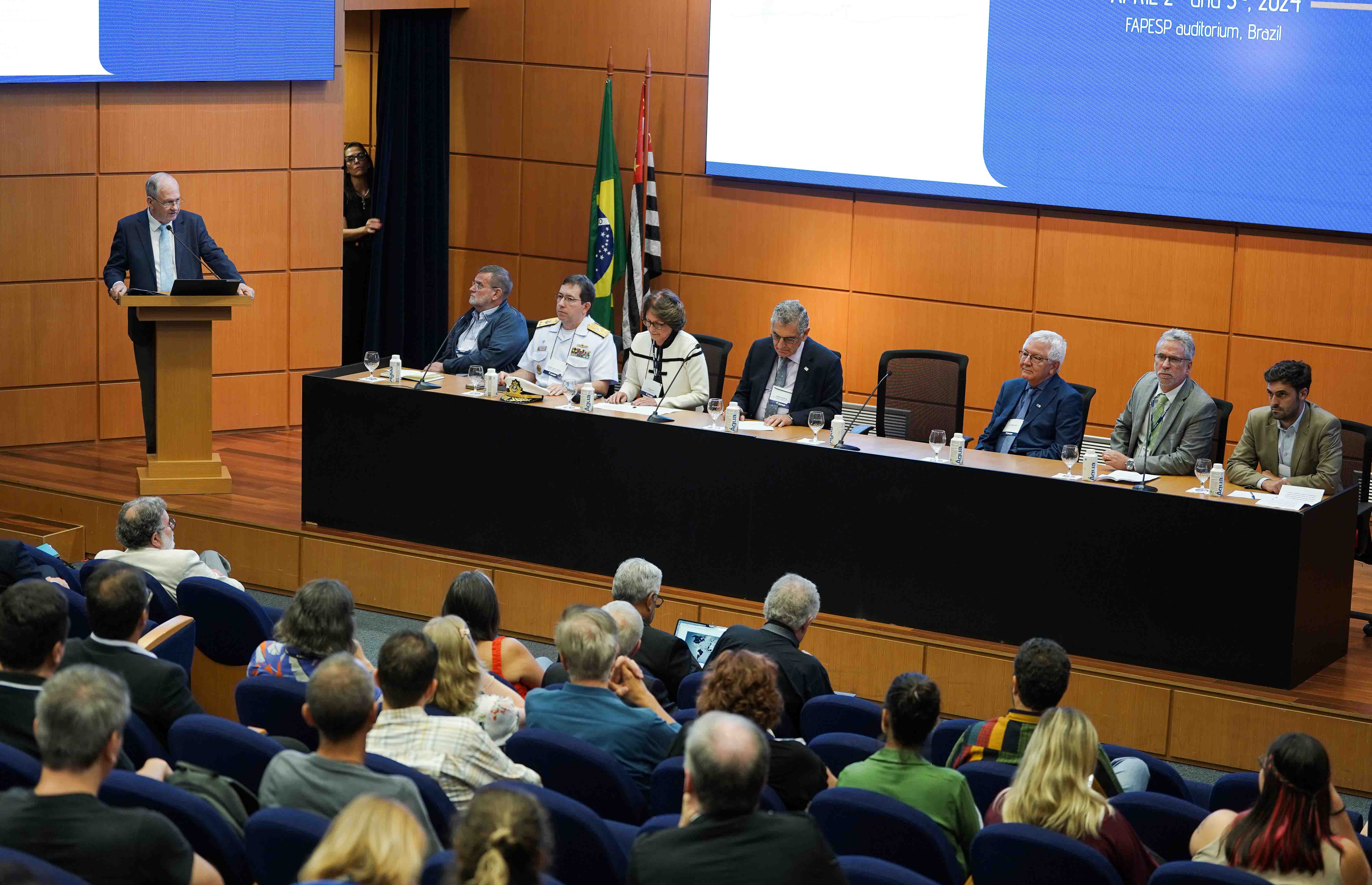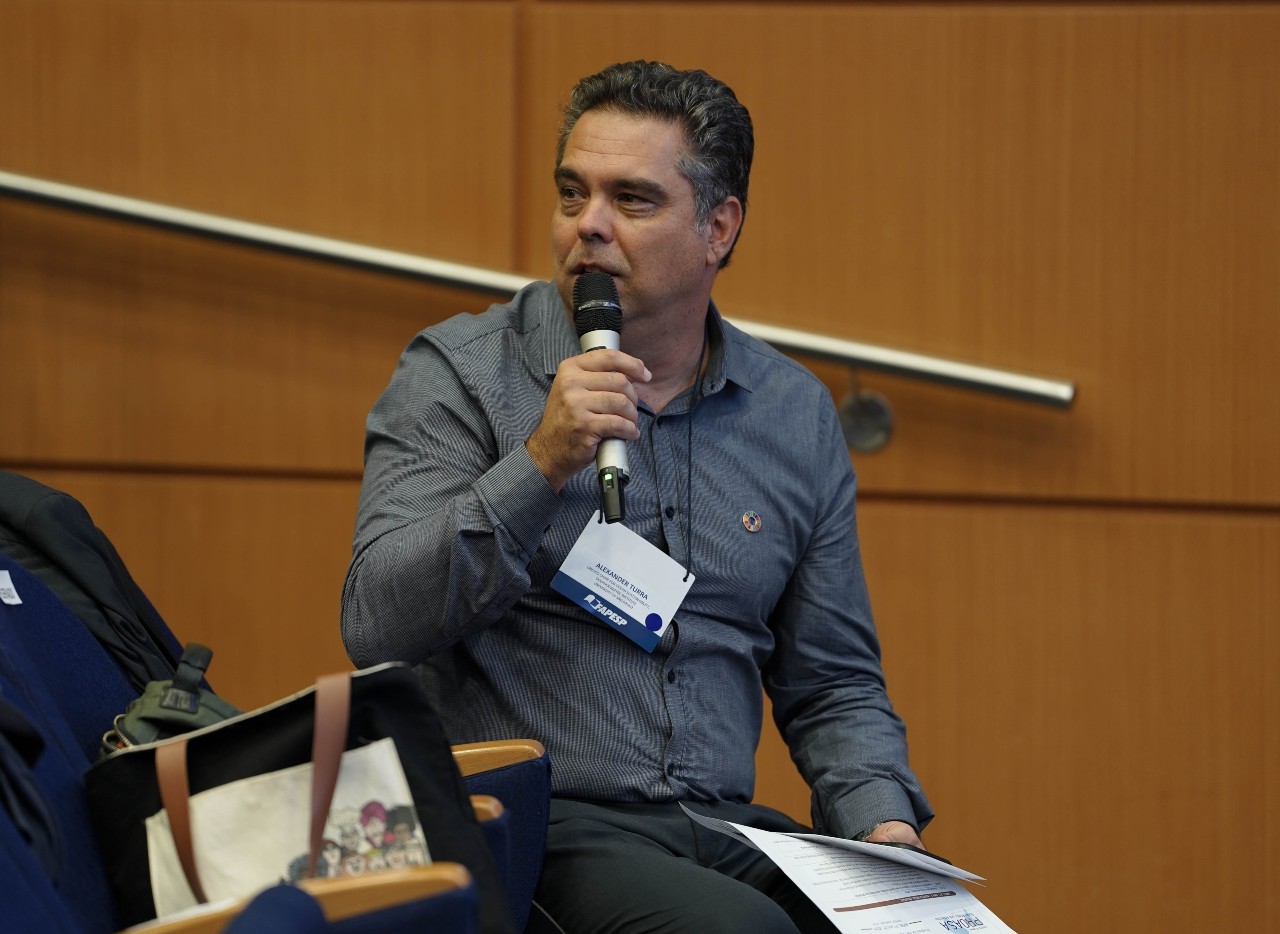


The program will initially last five years and will involve joint research projects, doctoral and postdoctoral scholarships, an annual oceanographic research conference, and funding for instrumentation (photo: Daniel Antônio/Agência FAPESP)
Published on 04/15/2024
By Elton Alisson | Agência FAPESP – The South Atlantic represents 11% of the world’s oceans in terms of total volume but relatively little is known about it in terms of scientific understanding and economic potential. To find out more, the Program for the South Atlantic and Antarctic (PROASA) was launched on April during a seminar at FAPESP.
PROASA aims to glean new knowledge of these two environments for use in addressing global crises and promoting sustainable development.
“The amount of data available on the South Atlantic is surprisingly small compared with the North Atlantic, for example. PROASA’s mission is to fill this gap and make new contributions in all knowledge areas, including physical and biological oceanography, ocean resources, and the region’s role in determining the rainfall regime, as well as economic questions, international relations, and science diplomacy,” Marco Antonio Zago, President of FAPESP, said in his opening remarks to the seminar. Researchers from Brazil, Argentina and France will participate in the program at the outset, but scientists from other countries are expected to join in time.
“The South Atlantic bathes three countries to the west [Brazil, Argentina and Uruguay] and five to the east [including South Africa, Namibia and Angola]. In Brazil, 14 states including São Paulo share its coastline. So there’s plenty of scope for expansion [of partnerships], which don’t need to be limited to countries or other Brazilian states,” Zago said.
According to Patricio Conejero Ortiz, Secretary for International Relations at the University of Buenos Aires (UBA), one of the Argentinian institutions involved, PROASA will help build scientific cooperation with Brazil and France. “Brazil is already Argentina’s main scientific partner in terms of joint publications, and France is the runner-up. Brazil and Argentina must deepen the integration of their scientific and technological capabilities in order to act as a system. Both countries have a solid basis, but this integration needs to be planned and financed,” Ortiz said.
French institutions joining the program include the National Center for Scientific Research (CNRS), France’s leading public funder of scientific research. For Gilles Pinay, Deputy Scientific Director of CNRS’s Institute of Ecology and Environment, PROASA will further reinforce the scientific collaboration between Brazil and France, which has gained momentum in recent weeks from the launching of joint initiatives with FAPESP and the University of São Paulo (USP) (read more at: agencia.fapesp.br/51330 and agencia.fapesp.br/51329).
“We’ll mobilize a large proportion of the research community in France, which has over 7,000 scientists, engineers, technicians, PhDs and postdocs working on marine sciences via partnerships between CNRS and 17 universities. We’ll also strive to align funding mechanisms and find ways to share our research vessels, as well as labs, long-term environmental research programs and field stations, especially in the sub-Antarctic and Antarctic for scientific cooperation,” Pinay said.
PROASA will also have the support of Brazil’s Interministerial Commission on Marine Resources (CIRM), a deliberative and consultative body that coordinates implementation of the national policy for marine resources, the Brazilian Antarctic Program, and the international coastal management plan, according to Rear Admiral Ricardo Jaques Ferreira, Secretary of CIRM.
“There’s a possibility of using CIRM to make PROASA even bigger,” Ferreira said. “The Brazilian Navy provides ships and aircraft to support scientific research in the sea, oceanic islands and the Antarctic, enabling researchers to travel on our vessels and use our facilities and science stations in remote locations. It’s also responsible for maritime spatial planning, the Antarctic Program and scientific research in the oceanic islands of the São Pedro and São Paulo and Trindade and Martim Vaz archipelagos.
“We already support 7,400 researchers, and are ready and willing to assist those who share the mission of researching, protecting and using the sea in an orderly and sustainable manner, and of understanding the processes that occur at high latitudes, their relationship with the South Atlantic, and their regional and global impact.”
Knowledge gaps
According to Ambassador Peter Thomson, the United Nations Secretary General’s Special Envoy for the Ocean, a report on the state of the ocean published in 2022 by the Intergovernmental Oceanographic Commission (IOC/UNESCO) showed that the quantitative description of the ocean is drastically incomplete.
“Our knowledge is insufficient,” Thomson said in a video played during the meeting. “I therefore warmly praise the launch of PROASA to help fill the gaps in knowledge of the South Atlantic and Southern Ocean, which play a huge role in the well-being of humankind.”
The results of the research conducted under the aegis of PROASA will also contribute to enhancement of climate models, so that the impact of climate change on the ocean can be predicted more accurately, said Thelma Krug, Chair of the Steering Committee of the Global Climate Observing System (GCOS), former Vice Chair of the Intergovernmental Panel on Climate Change (IPCC), and a member of FAPESP’s Board of Trustees.
“The oceans are responsible for absorbing some 25% of all greenhouse gas emissions, and scientists are troubled by not knowing whether this behavior will persist despite climate change,” Krug said.
“All climate models show that the oceans will be significantly affected by climate change in the current century. We therefore need observations to make climate models more robust as a basis for action in terms of adaptation and mitigation.”

Alexander Turra, coordinator of PROASA (photo: Daniel Antônio/Agência FAPESP)
PROASA’s remit with regard to infrastructure is to expand the system for observation and modeling of the South Atlantic and Antarctic, noted Alexander Turra, a professor at USP’s Oceanographic Institute and coordinator of the program.
“The idea is to create a digital representation of the South Atlantic and Antarctic in order to use science to reduce society’s vulnerability to the risks associated with the ocean, such as floods and landslides,” he said.
The program’s remit also relates to the environment and society. In the former case, the aim is to understand the structure, functioning and importance of the region’s socio-ecological systems and their connections. In the latter, it aims to develop a sustainable and equitable ocean economy by deploying transformative technologies.
“We also plan to take action to conserve and restore biodiversity and ecosystems via nature-based solutions, for example, and to understand and combat marine pollution,” Turra said.
According to Zago, PROASA will initially last five years and will involve joint research projects, doctoral and postdoctoral scholarships, an annual oceanographic research conference, and funding for instrumentation.
“A major goal of the program will be to create a large digital repository for participants to share data, with strong support from digital technology and artificial intelligence. In the weeks ahead, FAPESP will issue a call for proposals from young researchers who wish to participate. Participants will be required to lay the basis for a data center and repository to facilitate data collection and access for all,” Zago said.
The PROASA launch event was also attended by Marcio de Castro Silva Filho, Scientific Director of FAPESP; Olival Freire Junior, Scientific Director of the National Council for Scientific and Technological Development (CNPq); and Vahan Agopyan, São Paulo State Secretary for Science, Technology and Innovation.
Source: https://agencia.fapesp.br/51399